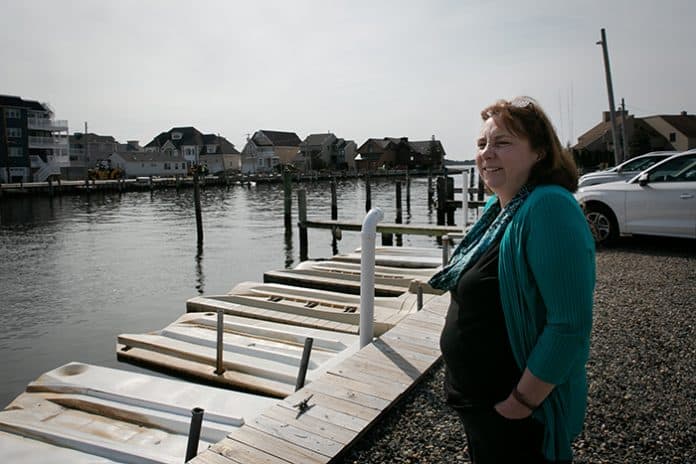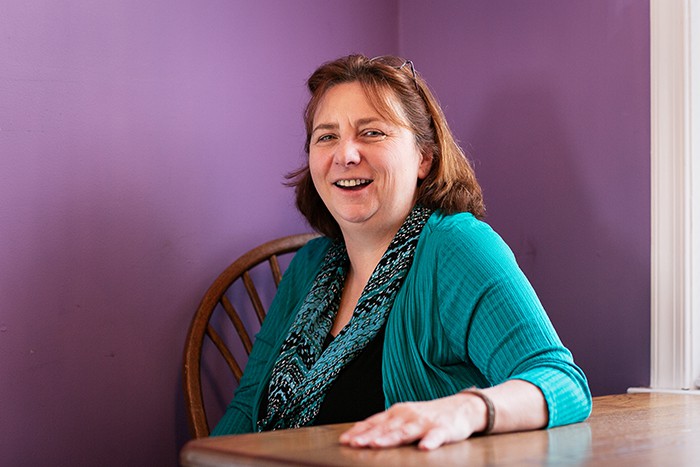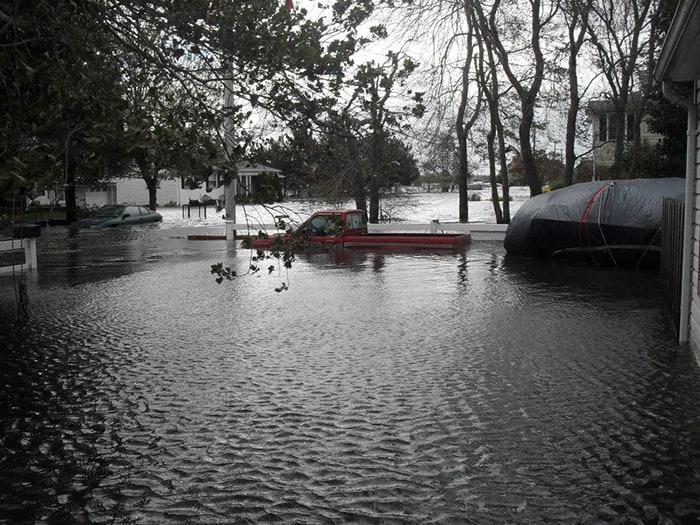
TOMS RIVER – There are two things North Jersey natives look forward to during their summers: a visit down the shore, and a day at Six Flags Great Adventure. This is true, at least, according to Deborah Mura.
She bought a house in the late 1980s just two blocks from where she resides now with her husband and children in Silverton’s Silver Bay section. A canal splits her block from the neighboring one, where the Silver Bay Harbor Association is located. Mura gave her children paradise, a permanent summer weekend of sorts.
Her first house, on Longman Street, flooded in 1992. The worst flooding she ever dealt with at her current house before Monday, Oct. 29, 2012 was a bit of water in her driveway when it rained.
“So when Sandy hit, I was like, ‘Oh, don’t worry about it. We flooded once before. Everything was fine 6 months later. It’s all going to be good.’ It didn’t quite work out that way,” Mura said.
Her family stayed.
The wind knocked down two trees in her yard that Sunday. A window broke, but Mura took it in stride.
That Monday morning, she and her teenaged son and daughter drove to the local grocery store for food. But the power cut out before they could make a purchase. They ended up at Wawa, buying the last bit of food available in the entire store.
“What is typical for people in my neighborhood, is, come high tide, you walk down, and you look. And so we did that. And high tide wasn’t that bad,” Mura said.
By the time they returned home, the power was out at their house. They decided to carve pumpkins by candlelight.
And then the phone rings. It was Mura’s father-in-law. He said her sister-in-law, who lives near Mura, just evacuated.
“What are you talking about? Everything’s fine,” Mura remembered saying.
But it wasn’t fine. The water line breeched and was pouring into the streets, and then homes. Mura went into her garage and found a foot of water inside. Her family quickly grabbed their bicycles and moved them, and found the water had rose another foot in just a few minutes. Mura’s husband and son managed to drive the family car up a few blocks. She, her daughter and the two dogs – the one had to swim out of the house – met them up there.
When Mura and her husband returned to their home the next morning – they waded through the water, a move she calls “stupid” – the old family pick-up truck used for chores and errands was submerged.
“I annoyed everyone, because I kept saying, ‘This is funny.’ I tend to make everything a joke and laugh everything off. I annoyed the crap out of lots of people, I’m sure,” Mura said. “Your house has four feet of water in it, nobody ever expects that. That’s kind of funny.”
Until it wasn’t.
“You don’t realize how bad things are emotionally, until suddenly you realize it,” she said. “You’re just coping and you’re trying.”
She took her children for a one-day trip to Disney World that January “just to get away from it all.”
“And I realized, I wasn’t enjoying Disney World,” she said.
She jumped into therapy and a support group for people suffering from post-traumatic stress disorder.

She also happened to be the mom who always drove around her daughter, 15 at the time, and her friends everywhere. And, sitting quietly in the driver’s seat, listened to their stories. She heard stories from the teens at her church. She heard stories from her students at Brookdale Community College in Lincroft, where she’s an associate professor of communications.
“I was always hearing stories, and it struck me that these young people were kind of forgotten,” Mura said.
Mura had been a journalist for years, locally with The Observer and The Asbury Park Press.
“I remember in the spring of that year [2013], going to my therapist and saying, ‘I’ve decided to write a novel,’ and worrying in the back of my head that I’m just saying this and I’m never going to do it.”
The well-worn adage to wannabe novelists is this: Write what you know. The teens’ stories inspired “Stronger Than The Storm,” the novel that Mura did wind up writing about Superstorm Sandy and its aftermath. What is normal after wind and water and mold wrecked homes and entire neighborhoods?
A coworker in Belmar lost his home in the storm. He recounted to Mura that Red Cross workers combed the neighborhood the day after Sandy, and offered him a board game: Monopoly.
“‘While you’re dealing with this, don’t forget your kids.’ He was so pissed, and I was pissed with him. And, I wanted to put that in the book, and then towards the end of writing it, it doesn’t fit in the book, because the whole book is exactly about that message,” Mura said. “Because they did get lost.”
The novel opens with a scene similar to what Mura described about her evening Oct. 29, 2012. Families who have known each other for years are gathering to watch high tide come in the evening before Sandy made landfall. “Are we safe?” the main character, 15-year-old Lacey Freshet, asks in the book’s opening line. The families are carefree, even joking, not the least bit impressed by this storm that will eventually bring with it death and destruction. Once settling into a board game by candlelight back at home, Lacey gets the call from her best friend and love interest, MacGyver Anderson, to evacuate immediately. She thinks he’s joking. He’s not. The water is rising, fast.
While the novel draws on stories from real life, it’s not a fiction-masked memoir.
The story follows Lacey, who stays in Silver Bay, and MacGyver, who moves to Florida with his family two days after Sandy, and how they struggle to not only remain connected to each other but to any semblance of normal while parents juggle jobs and clean-up. There’s the school dance. Homework. Underage drinking. First sexual experiences. Summer school. Divorce. Support groups. And a raft. Just like in real life, some families remained and rebuilt. Others relocated. And still, some could not afford to stay.
“You have these two very serious full-time jobs already, your own job and you’re dealing with every day is a new problem, literally, every day is a new problem. You think you’re going in one direction, and you get clobbered in a different direction every single day,” Mura said. “And the other thing is, all the normal rituals the kids go through, were done under this cloud. You couldn’t go a day and not hear talk about Sandy. I would say probably for 2 years.”
The teens lost that sense of community they grew up with. Their parents were distracted, in real life and in the book.
“When you drive kids around, you try your best to keep your mouth shut, and also, to not let them go too far over the top. So, I heard a lot of, ‘My parents don’t care.’ It’s not that! It’s not that they don’t care, it’s that they’re trying to get your house back for you!” Mura said.
At the shore for so many, life is described in terms of before Sandy and after Sandy, something Mura captures in “Stronger Than The Storm.”
“It was as if time split. And you could get back to Halloween, because we almost got to Halloween, and then we didn’t. If you could get back to Halloween and get back on that time path. And that’s what [the characters] want to do. They just want to get back to their normal life, and they’re trying to figure out how to do that. And they’re not giving up on that idea,” Mura said.
The novel ends three days before the one-year anniversary of Sandy, on a somewhat hopeful note. And life does go on, post-Sandy. Mura gave The Toms River Times an interview from her home, now raised 4 feet. Rain floods her driveway now. Some neighbors’ homes have been raised 2 or 3 feet, some – mostly the bi-levels – not at all, because they couldn’t withstand the raising. Across the canal, small construction vehicles are working on some properties that flood with any rain now, because of Sandy.
“I want young people to get the message I intended. I want to get the book to them. I would like people in the area who’ve gone through it to see if from a different angle, just to get that understanding, because that’s why I wrote it. And mainly, and what I hope to do with the book, is go down to North Carolina with it, and go to the panhandle, because, it’s for those people. It’s for those kids. The ones who, it’s almost a year and everything’s supposed to be better. And I’m sure everyone else’s life is better. It’s for them. I really want to get the book into those hands.
“We can live though and get through so much. Human beings are so much stronger than we give ourselves credit for. And ultimately, I hope especially when young people read it, they understand that when you help someone else, especially when you do it without trying to help yourself, you help yourself,” Mura said.

All proceeds from “Stronger Than the Storm” are going to People’s Pantry in Toms River and Helping Hands, The Food Pantry at Brookdale Community College.
The book is available through Amazon.com, or hard copies can be purchased at Silverton Pharmacy in Toms River, the Scroll and Pen Bookstore on Brookdale’s Lincroft campus.
Mura will be giving a talk about her book 7 p.m. April 10 during Brookdale’s Visiting Writers Series, held at the BCC Student Life Center, Navesink III.
She’ll also be featured at the fifth annual Brookdale Writer Read 7 p.m. April 12 at 33 Monmouth St. in Red Bank.
For more information, visit strongerthanthestormbook.com.






